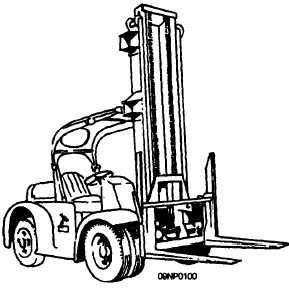| |
CHAPTER 13
MATERIALS-HANDLING EQUIPMENT
To keep the Navy supplied with the huge volume of
material it needs, many types of handling equipment
have been designed to haul, unload, stow, and issue this
material. It is important for you to remember that
whether the job is handling or stowing material, a piece
of equipment is usually available for the job. Any piece
of materials handling equipment is only as efficient as
the person operating it. If the equipment is not used for
the job for which it was built, efficiency is lost.
Throughout your Navy career, you may be required
to operate or supervise an operation using
materials-handling equipment Therefore, you should
be familiar with the types of materials-handling
equipment commonly used at naval activities. Storage
and Materials Handling, DOD 4145.19-R-1; Naval
Ships’ Technical Manual, chapter 572; Storage and
Materials Handling, NAVSUP P-284; and the Navy
Supplement, NAVSUP P-284-1, give detailed
information about materials-handling equipment.
TYPES OF MATERIALS-HANDLING
EQUIPMENT
Descriptions and uses of handling equipment
normally found in supply operations are contained in
the paragraphs that follow.
FORKLIFT TRUCK
The forklift truck is the most widely used
powerdriven piece of handling equipment used by the
supply department. It is designed to pickup, carry, and
stack palletized unit loads of supplies and equipment.
Standard forklift trucks are available with lifting
capacities of 2,000 to 15,000 pounds and lifting heights
of 100 to 210 inches.
Forklift trucks are equipped with telescopic masts
that permit loads to be lifted beyond the height of the
collapsed mast. Most trucks have free lift, which is the
height to which the forks can be raised before the inner
slides move upward from the mast and increase the
overall height.
Gasoline-powered forklift trucks may be equipped
with solid rubber or semisolid tires for use in
warehouses, or with pneumatic tires for use in outdoor
1
1
storage areas. Electric-powered forklift trucks are
equipped with solid rubber or semisolid tires for indoor
Operations only.
Forklift trucks are generally used in the handling of
palletized unit load. They may also be used for hauling
boxes or containers equipped with skids and other large
rigid containers or packages. They are used aboard
ship, on barges, on piers, in warehouses in freight
terminals, and on the ground to hoist heavy containers.
[n yards which are not covered with hard surfaces, the
bucks must be equipped with pneumatic tires in order
to operate efficiently.
While forklift trucks may occasionally be used in
place of tractors, their greatest efficiency is obtained in
their use for elevating palletized loads into storage and
for handling palletized loads between hauling
operations. They should not travel with individual
loads for distances of more than 400 feet. If the
operation requires longer travel, the trucks should be
supplemented by tractor-trailer trains or other materials
handling equipment, Personnel should use a forklift
truck at each end of the haul for loading, unloading, and
stacking. A 15,000-pound, pneumatic the, forklift
truck is shown in figure 13-1.
Figure 13-1.-Forklift truck.
13-1
|

